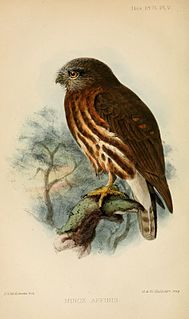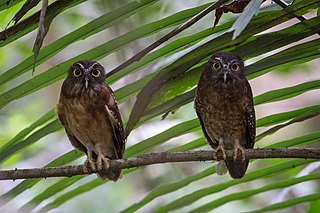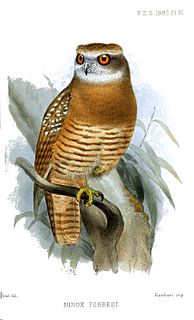 W
WNinox is a genus of true owls comprising about 30 species found in Asia and Australasia. Many species are known as hawk-owls or boobooks, but the northern hawk-owl Surnia ulula is not a member of this genus. Molecular analysis indicates the genus is an early offshoot from the ancestors of the rest of the true owls, and are maybe best-classified in a subfamily Ninoxinae with the genera Sceloglaux and Uroglaux. The genus was introduced by the English naturalist Brian Houghton Hodgson in 1837.
 W
WThe Andaman hawk-owl or Andaman boobook is a species of owl in the family Strigidae. It is endemic to the Andaman Islands.
 W
WThe barking owl, also known as the winking owl, is a nocturnal bird species native to mainland Australia and parts of Papua New Guinea and the Moluccas. They are a medium-sized brown owl and have a characteristic voice with calls ranging from a barking dog noise to a shrill human-like howl of great intensity.
 W
WThe brown hawk-owl, also known as the brown boobook, is an owl which is a resident breeder in south Asia from India, Sri Lanka, Bangladesh and Nepal east to western Indonesia and south China.
 W
WThe Christmas boobook, also known more specifically as the Christmas Island hawk-owl, is a species of owl in the family Strigidae.
 W
WThe Halmahera boobook is a species of owl in the family Strigidae. It inhabits the Indonesian islands of Halmahera, Ternate and Bacan. Its natural habitat is subtropical or tropical moist lowland forests. It is threatened by habitat loss. It was previously considered to be a subspecies of the Moluccan boobook.
 W
WHume's hawk-owl or Hume's boobook is a species of owl in the family Strigidae endemic to the Andaman Islands. Its natural habitats are subtropical or tropical moist lowland forests and subtropical or tropical mangrove forests. It is becoming rare due to habitat loss.
 W
WThe Lord Howe boobook, also known as the Lord Howe morepork, was a bird in the true owl family endemic to Lord Howe Island in the Tasman Sea, part of New South Wales, Australia. It is an extinct and little-known subspecies of the morepork.
 W
WThe Luzon hawk-owl or Luzon boobook is a species of owl in the family Strigidae. It is endemic to the Philippines where it lives in forests. It is a brown and white mottled bird and males and females look much alike.
 W
WThe Moluccan boobook or Moluccan hawk-owl group, are a group of owls in the family Strigidae. They are found in Indonesia. Once consider a single species, the four species are now considered part of a species complex. Natural habitat for all species is subtropical or tropical moist lowland forests.
 W
WThe morepork, also called the ruru or Tasmanian spotted owl, is a small brown owl found throughout New Zealand and Tasmania. Described by Johann Friedrich Gmelin in 1788, it was for many years considered to be the same species as the Australian boobook of mainland Australia until 1999. Its name is derived from its two-tone call. Four subspecies of the morepork are recognized, one of which is extinct and another that exists only as a hybrid population. The bird has almost 20 alternative common names, including mopoke and boobook—many of these names are onomatopoeic, as they emulate the bird's distinctive two-pitched call.
 W
WThe New Britain boobook, also known as the spangled boobook, New Britain hawk-owl or Russet hawk-owl, is a small owl that is endemic to New Britain, the largest island in the Bismarck Archipelago in Papua New Guinea.
 W
WThe New Ireland boobook also known as the Bismarck hawk owl or Bismarck boobook, is a small to medium-sized owl measuring 25 to 30 cm in length. It is a dark rufous-brown above, with barred scapular feathers and variable amounts of spotting or barring on the wings and tail. Its underparts are whitish, with an unmarked pale throat, a dark barred upper breast and barring on the remainder of the underparts. Its face is dark brown, its eyes are brown or yellow, and its bill and legs are yellow. It is short-tailed and has heavy tarsi.
 W
WThe Norfolk boobook, also known as the Norfolk Island boobook, Norfolk Island owl or Norfolk Island morepork, was a bird in the true owl family endemic to Norfolk Island, an Australian territory in the Tasman Sea between Australia and New Zealand. It is an extinct subspecies of the morepork. However, although the taxon is extinct, its genes live on in the descendants of the hybrid offspring of the last female bird, which was sighted for the last time in 1996.
 W
WThe northern boobook belongs to the family Strigidae and is a raptorial owl endemic to eastern and southern countries of Asia. The species was considered, until recently, a conspecific of Ninox scutulata or brown boobook, a species of similar distribution encompassing 11 subspecies. The species currently includes two subspecies, the migrant Ninox japonica japonica and the non-migrant Ninox japonica totogo. Despite being considered as the most common breeding owl in Japan, little research has been conducted on the species and subspecies and the taxonomic classification of N.j.togoto and N.j.japonica has been a subject of debate. There are no indications of significant decline in northern boobook populations and therefore, its conservation status has been classified as least concern by the IUCN Red List.
 W
WThe ochre-bellied boobook is a species of owl in the family Strigidae. It is endemic to Sulawesi, Indonesia. Its natural habitats are subtropical or tropical dry forests and subtropical or tropical moist lowland forests. It is threatened by habitat loss.
 W
WThe powerful owl is a species of owl native to south-eastern and eastern Australia, the largest owl on the continent. It is found in coastal areas and in the Great Dividing Range rarely more than 200 km (120 mi) inland. The International Union for Conservation of Nature (IUCN) Red List of Threatened Species also refers to this species as the powerful boobook. An apex predator in its narrow distribution, the powerful owl is often an opportunist like most predators, but generally is dedicated to hunting arboreal mammals, in particular small to medium-sized marsupials. Such prey can comprise about three-quarters of their diet. Generally, this species lives in primary forests with tall, native trees, but can show some habitat flexibility when not nesting. The powerful owl is a typically territorial raptorial bird that maintains a large home range and has long intervals between egg-laying and hatching of clutches. Also, like many types of raptorial bird, they must survive a long stretch to independence in young owls post-fledging. Unlike most raptorial birds, however, male powerful owls are larger and stronger than females and so the male takes the dominant position in the mating pair, which extends to food distribution.
 W
WThe rufous owl, also known as the rufous boobook, is a species of owl in the family Strigidae. It was described in 1846 by John Gould, an English ornithologist. Its common name reflects the rufous-coloured feathers that these owls are covered with in adulthood. While it is uncommon, the species has a wide range, including Australia, Indonesia, and Papua New Guinea.
 W
WThe Seram boobook is a species of owl in the family Strigidae. It is found on the Indonesian islands of Seram, Kelang and Ambon. Its natural habitat is subtropical or tropical moist lowland forests. It is threatened by habitat loss. It used to be considered a subspecies of the Moluccan boobook.
 W
WThe Solomons boobook, also known as the Solomons hawk-owl, is a small to medium-sized hawk owl, measuring 23–31 cm (9.1–12.2 in) in length. Its upperparts are rusty brown, sometimes spotted or barred with white, its chest is buffy white, sometimes spotted or barred with brown, and its creamy belly is unmarked. It has a grayish-brown facial disc, edged by narrow white eyebrows and a band of white across the throat.
 W
WThe Australian boobook is a species of owl native to mainland Australia, southern New Guinea, the island of Timor, and the Sunda Islands. Described by John Latham in 1801, it was generally considered to be the same species as the morepork of New Zealand until 1999. Its name is derived from its two-tone boo-book call. Eight subspecies of the Australian boobook are recognized, with three further subspecies being reclassified as separate species in 2019 due to their distinctive calls and genetics.
 W
WThe Sumba boobook is a species of owl in the family Strigidae. It is endemic to Sumba in the Lesser Sunda Islands of Indonesia. Its natural habitats are subtropical or tropical dry forest and subtropical or tropical moist lowland forest. It is threatened by habitat loss.
 W
WThe Tanimbar boobook, or Tanimbar hawk-owl, is a species of owl in the family Strigidae. It is found in the Tanimbar Islands of Indonesia. Its natural habitat is subtropical or tropical moist lowland forests. It is threatened by habitat loss. It used to be considered a subspecies of the Moluccan boobook.
 W
WThe Togian boobook or Togian hawk-owl is an owl (Strigidae) described as new to science in 2004. The bird is currently known only from three islands in the Togian group, an archipelago in the Gulf of Tomini off the coast of Sulawesi, Indonesia. The new species was discovered on 25 December 1999.